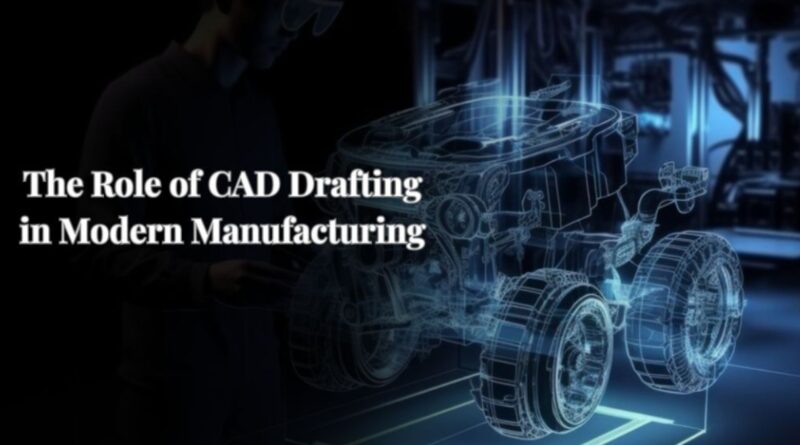The Role of CAD Drafting in Modern Manufacturing
In the dynamic world of modern manufacturing, precision, efficiency, and innovation are paramount. Computer-Aided Design (CAD) drafting has become a cornerstone of this industry, transforming how products are conceptualized, designed, and brought to market. This article explores the pivotal role of CAD drafting in modern manufacturing, highlighting its impact on design processes, production efficiency, and overall product quality.
The Evolution of CAD Drafting
CAD drafting has evolved significantly since its inception in the 1960s. Initially, CAD systems were primarily used for creating basic geometric shapes and simple drawings. However, advancements in computer technology and software capabilities have expanded the scope and complexity of CAD applications. Today, CAD drafting encompasses 2D and 3D modeling, simulations, and integrations with other manufacturing technologies, such as Computer-Aided Manufacturing (CAM) and 3D printing.
Enhancing Design Precision and Flexibility
One of the primary advantages of CAD drafting is the precision it offers in design creation. Traditional hand-drawn sketches and blueprints often suffered from human error and inconsistencies. CAD drafting eliminates these issues by allowing designers to create accurate, detailed digital models. These models can be easily modified and optimized, ensuring that every aspect of the design meets the required specifications.
Moreover, CAD drafting services provides unparalleled flexibility. Designers can experiment with different materials, shapes, and configurations without the need for physical prototypes. This ability to iterate quickly and efficiently accelerates the design process and fosters innovation. For instance, designers can use CAD software to simulate how a product will perform under various conditions, identifying potential issues before they arise in the manufacturing phase.
Streamlining Production Processes
The integration of CAD drafting with modern manufacturing technologies has streamlined production processes considerably. CAD models serve as the foundation for CAM systems, which use the digital designs to control machinery and automate manufacturing tasks. This integration reduces the likelihood of errors, enhances repeatability, and significantly speeds up production.
In addition, CAD drafting facilitates better communication and collaboration among different teams involved in the manufacturing process. Engineers, designers, and production managers can work from the same digital model, ensuring that everyone is on the same page. This shared understanding minimizes misunderstandings and reduces the risk of costly errors or delays.
Improving Product Quality and Performance
The precision and accuracy of CAD drafting directly contribute to improved product quality. Detailed digital models allow for thorough testing and validation before manufacturing begins. Engineers can perform finite element analysis (FEA) and other simulations to predict how a product will behave under real-world conditions. This proactive approach helps identify potential weak points and optimize the design for better performance and durability.
Furthermore, CAD drafting supports the creation of complex geometries and intricate designs that would be challenging or impossible to achieve with traditional methods. Advanced features such as parametric modeling enable designers to create components with exact dimensions and tolerances. This level of detail ensures that the final product meets stringent quality standards and performs as intended.
Supporting Customization and Personalization
In today’s market, customization and personalization are increasingly important. Consumers demand products tailored to their specific needs and preferences. CAD drafting plays a crucial role in meeting this demand by enabling manufacturers to quickly and efficiently produce customized designs.
With CAD software, designers can easily modify existing models or create new ones based on customer specifications. This capability is particularly valuable in industries such as automotive, aerospace, and medical devices, where custom solutions are often required. The ability to offer personalized products not only enhances customer satisfaction but also provides a competitive edge in the marketplace.
Reducing Costs and Resource Usage
CAD drafting contributes to cost reduction in several ways. By identifying and resolving design issues early in the process, it minimizes the need for costly revisions and rework. The accuracy and precision of digital models also reduce material waste, as components are designed to fit together perfectly.
Additionally, CAD drafting enables virtual prototyping, which significantly cuts down on the time and expense associated with physical prototyping. Manufacturers can test and refine designs in a virtual environment, only moving to physical prototypes once the design is finalized and validated. This approach not only saves money but also shortens the overall development cycle.
Facilitating Innovation and Future Trends
The role of CAD drafting in modern manufacturing extends beyond current practices to influence future trends and innovations. As technology continues to advance, CAD software is becoming more integrated with other digital tools and platforms. For example, the rise of the Internet of Things (IoT) and Industry 4.0 is leading to more connected and intelligent manufacturing environments. CAD models can be linked with IoT devices to monitor and optimize production processes in real-time.Additionally, embedded software development services play a crucial role in integrating and managing these IoT devices, ensuring seamless communication and functionality within the manufacturing ecosystem.
Moreover, the advent of artificial intelligence (AI) and machine learning is poised to revolutionize CAD drafting. AI algorithms can analyze vast amounts of data to suggest design improvements, predict performance outcomes, and automate repetitive tasks. These advancements will further enhance the efficiency and effectiveness of CAD drafting in manufacturing.
Conclusion
CAD drafting has become an indispensable tool in modern manufacturing, driving precision, efficiency, and innovation across the industry. Its ability to enhance design accuracy, streamline production processes, improve product quality, support customization, reduce costs, and facilitate future trends underscores its critical role. As technology continues to evolve, the importance of CAD drafting in manufacturing will only grow, paving the way for more advanced, efficient, and innovative production methods. For companies seeking to stay competitive, investing in CAD drafting capabilities and leveraging advanced CAD drafting services is not just an option, but a necessity.

